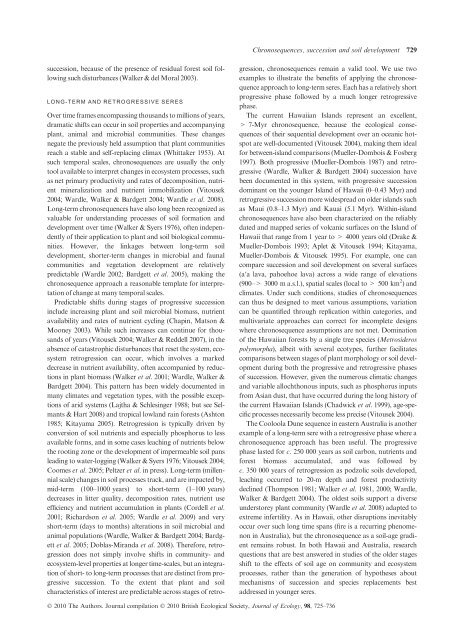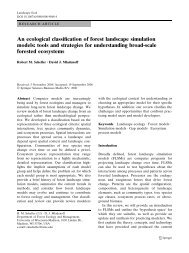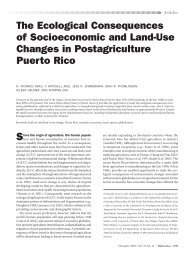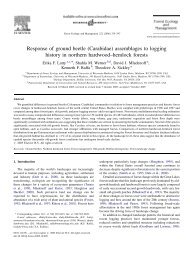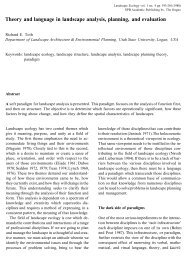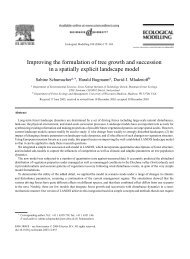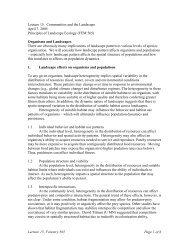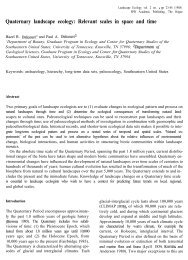The use of chronosequences in studies of ecological succession ...
The use of chronosequences in studies of ecological succession ...
The use of chronosequences in studies of ecological succession ...
Create successful ePaper yourself
Turn your PDF publications into a flip-book with our unique Google optimized e-Paper software.
Chronosequences, <strong>succession</strong> and soil development 729<strong>succession</strong>, beca<strong>use</strong> <strong>of</strong> the presence <strong>of</strong> residual forest soil follow<strong>in</strong>gsuch disturbances (Walker & del Moral 2003).LONG-TERM AND RETROGRESSIVE SERESOver time frames encompass<strong>in</strong>g thousands to millions <strong>of</strong> years,dramatic shifts can occur <strong>in</strong> soil properties and accompany<strong>in</strong>gplant, animal and microbial communities. <strong>The</strong>se changesnegate the previously held assumption that plant communitiesreach a stable and self-replac<strong>in</strong>g climax (Whittaker 1953). Atsuch temporal scales, <strong>chronosequences</strong> are usually the onlytool available to <strong>in</strong>terpret changes <strong>in</strong> ecosystem processes, suchas net primary productivity and rates <strong>of</strong> decomposition, nutrientm<strong>in</strong>eralization and nutrient immobilization (Vito<strong>use</strong>k2004; Wardle, Walker & Bardgett 2004; Wardle et al. 2008).Long-term <strong>chronosequences</strong> have also long been recognized asvaluable for understand<strong>in</strong>g processes <strong>of</strong> soil formation anddevelopment over time (Walker & Syers 1976), <strong>of</strong>ten <strong>in</strong>dependently<strong>of</strong> their application to plant and soil biological communities.However, the l<strong>in</strong>kages between long-term soildevelopment, shorter-term changes <strong>in</strong> microbial and faunalcommunities and vegetation development are relativelypredictable (Wardle 2002; Bardgett et al. 2005), mak<strong>in</strong>g thechronosequence approach a reasonable template for <strong>in</strong>terpretation<strong>of</strong> change at many temporal scales.Predictable shifts dur<strong>in</strong>g stages <strong>of</strong> progressive <strong>succession</strong><strong>in</strong>clude <strong>in</strong>creas<strong>in</strong>g plant and soil microbial biomass, nutrientavailability and rates <strong>of</strong> nutrient cycl<strong>in</strong>g (Chap<strong>in</strong>, Matson &Mooney 2003). While such <strong>in</strong>creases can cont<strong>in</strong>ue for thousands<strong>of</strong> years (Vito<strong>use</strong>k 2004; Walker & Reddell 2007), <strong>in</strong> theabsence <strong>of</strong> catastrophic disturbances that reset the system, ecosystemretrogression can occur, which <strong>in</strong>volves a markeddecrease <strong>in</strong> nutrient availability, <strong>of</strong>ten accompanied by reductions<strong>in</strong> plant biomass (Walker et al. 2001; Wardle, Walker &Bardgett 2004). This pattern has been widely documented <strong>in</strong>many climates and vegetation types, with the possible exceptions<strong>of</strong> arid systems (Lajtha & Schles<strong>in</strong>ger 1988; but see Selmants& Hart 2008) and tropical lowland ra<strong>in</strong> forests (Ashton1985; Kitayama 2005). Retrogression is typically driven byconversion <strong>of</strong> soil nutrients and especially phosphorus to lessavailable forms, and <strong>in</strong> some cases leach<strong>in</strong>g <strong>of</strong> nutrients belowthe root<strong>in</strong>g zone or the development <strong>of</strong> impermeable soil panslead<strong>in</strong>g to water-logg<strong>in</strong>g (Walker & Syers 1976; Vito<strong>use</strong>k 2004;Coomes et al. 2005; Peltzer et al. <strong>in</strong> press). Long-term (millennialscale) changes <strong>in</strong> soil processes track, and are impacted by,mid-term (100–1000 years) to short-term (1–100 years)decreases <strong>in</strong> litter quality, decomposition rates, nutrient <strong>use</strong>efficiency and nutrient accumulation <strong>in</strong> plants (Cordell et al.2001; Richardson et al. 2005; Wardle et al. 2009) and veryshort-term (days to months) alterations <strong>in</strong> soil microbial andanimal populations (Wardle, Walker & Bardgett 2004; Bardgettet al. 2005; Doblas-Miranda et al. 2008). <strong>The</strong>refore, retrogressiondoes not simply <strong>in</strong>volve shifts <strong>in</strong> community- andecosystem-level properties at longer time-scales, but an <strong>in</strong>tegration<strong>of</strong> short- to long-term processes that are dist<strong>in</strong>ct from progressive<strong>succession</strong>. To the extent that plant and soilcharacteristics <strong>of</strong> <strong>in</strong>terest are predictable across stages <strong>of</strong> retrogression,<strong>chronosequences</strong> rema<strong>in</strong> a valid tool. We <strong>use</strong> twoexamples to illustrate the benefits <strong>of</strong> apply<strong>in</strong>g the chronosequenceapproach to long-term seres. Each has a relatively shortprogressive phase followed by a much longer retrogressivephase.<strong>The</strong> current Hawaiian Islands represent an excellent,> 7-Myr chronosequence, beca<strong>use</strong> the <strong>ecological</strong> consequences<strong>of</strong> their sequential development over an oceanic hotspotare well-documented (Vito<strong>use</strong>k 2004), mak<strong>in</strong>g them idealfor between-island comparisons (Mueller-Dombois & Fosberg1997). Both progressive (Mueller-Dombois 1987) and retrogressive(Wardle, Walker & Bardgett 2004) <strong>succession</strong> havebeen documented <strong>in</strong> this system, with progressive <strong>succession</strong>dom<strong>in</strong>ant on the younger Island <strong>of</strong> Hawaii (0–0.43 Myr) andretrogressive <strong>succession</strong> more widespread on older islands suchas Maui (0.8–1.3 Myr) and Kauai (5.1 Myr). With<strong>in</strong>-island<strong>chronosequences</strong> have also been characterized on the reliablydated and mapped series <strong>of</strong> volcanic surfaces on the Island <strong>of</strong>Hawaii that range from 1 year to > 4000 years old (Drake &Mueller-Dombois 1993; Aplet & Vito<strong>use</strong>k 1994; Kitayama,Mueller-Dombois & Vito<strong>use</strong>k 1995). For example, one cancompare <strong>succession</strong> and soil development on several surfaces(a‘a lava, pahoehoe lava) across a wide range <strong>of</strong> elevations(900–> 3000 m a.s.l.), spatial scales (local to > 500 km 2 )andclimates. Under such conditions, <strong>studies</strong> <strong>of</strong> <strong>chronosequences</strong>can thus be designed to meet various assumptions, variationcan be quantified through replication with<strong>in</strong> categories, andmultivariate approaches can correct for <strong>in</strong>complete designswhere chronosequence assumptions are not met. Dom<strong>in</strong>ation<strong>of</strong> the Hawaiian forests by a s<strong>in</strong>gle tree species (Metrosiderospolymorpha), albeit with several ecotypes, further facilitatescomparisons between stages <strong>of</strong> plant morphology or soil developmentdur<strong>in</strong>g both the progressive and retrogressive phases<strong>of</strong> <strong>succession</strong>. However, given the numerous climatic changesand variable allochthonous <strong>in</strong>puts, such as phosphorus <strong>in</strong>putsfrom Asian dust, that have occurred dur<strong>in</strong>g the long history <strong>of</strong>the current Hawaiian Islands (Chadwick et al. 1999), age-specificprocesses necessarily become less precise (Vito<strong>use</strong>k 2004).<strong>The</strong> Cooloola Dune sequence <strong>in</strong> eastern Australia is anotherexample <strong>of</strong> a long-term sere with a retrogressive phase where achronosequence approach has been <strong>use</strong>ful. <strong>The</strong> progressivephase lasted for c. 250 000 years as soil carbon, nutrients andforest biomass accumulated, and was followed byc. 350 000 years <strong>of</strong> retrogression as podzolic soils developed,leach<strong>in</strong>g occurred to 20-m depth and forest productivitydecl<strong>in</strong>ed (Thompson 1981; Walker et al. 1981, 2000; Wardle,Walker & Bardgett 2004). <strong>The</strong> oldest soils support a diverseunderstorey plant community (Wardle et al. 2008) adapted toextreme <strong>in</strong>fertility. As <strong>in</strong> Hawaii, other disruptions <strong>in</strong>evitablyoccur over such long time spans (fire is a recurr<strong>in</strong>g phenomenon<strong>in</strong>Australia),butthechronosequenceas a soil-age gradientrema<strong>in</strong>s robust. In both Hawaii and Australia, researchquestions that are best answered <strong>in</strong> <strong>studies</strong> <strong>of</strong> the older stagesshift to the effects <strong>of</strong> soil age on community and ecosystemprocesses, rather than the generation <strong>of</strong> hypotheses aboutmechanisms <strong>of</strong> <strong>succession</strong> and species replacements bestaddressed <strong>in</strong> younger seres.Ó 2010 <strong>The</strong> Authors. Journal compilation Ó 2010 British Ecological Society, Journal <strong>of</strong> Ecology, 98, 725–736


